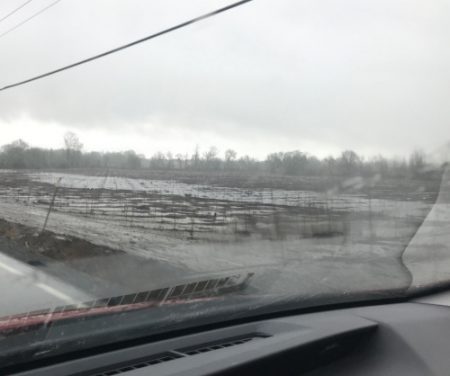Winter is a great time to check on how water moves through your property. Intense and continued rainfall onto saturated soil provides insights into water flow above and below ground. The larger the water movement, the more attention needs to be focused on keeping those areas healthy. Along streams, due to their dynamic nature, bank areas are vulnerable to higher rates of erosion. Unprotected, these forces can wash away productive land.

Figure 1: Erosion channel into ditch
Where are your problem areas?
As you walk your property, take a closer look when you see muddy water flowing. Are there areas nearby that have bare soil? Clear signs would be active gullies coming into the flow, or freshly eroded banks. In areas where there is adequate vegetation, then follow the water course up hill and try to find where the erosion is starting. In some cases, you will get to the edge of your property and find out that your neighbor uphill is losing some of their precious soil.
Another area to focus on includes flatter areas that have “sheet flow” of water. Sheet flow happens when rain falls faster than the ground can absorb it, whether it is saturated or not. Even with class A soils, compacted areas can experience this and take valuable nutrients away from your crops as well as add excess fertilizer and pesticides into the waterways. Having cover crops or vegetative cover will dramatically reduce the erosion.

Figure 2: Sheet flow
Sheet Erosion – See for yourself!
Find a field slope, the steepness of it does not matter but it should outlet at a field edge. Place small wood boards perpendicular to the slope. The boards can be any size, say 2′ long and 2″ wide and 1/4 to 3/4″ thick. Place them on the soil and anchor them with small stakes. They are just dams to stop the flow of water and sediment. The depth of soil behind them that will accumulate during a rain event will determine the amount of soil loss.
For those with animals, grazing activity can be a situation where the vegetation gets damaged to the point of erosion. Stream bank areas are especially vulnerable to animal degradation as well as introducing manure into the waterway.
Strategies to Protect Soil
The largest opportunity to protect soil and water quality lies with the vegetation. Not only does the vegetation take the impact of the rain, but its roots also bind the soil together. Vegetation slows the water, allowing time for the water to infiltrate the soil. The healthier your soil is, the better its structure, and this leads to greater water holding capacity. Did you know that a 1% gain in soil carbon can increase the water holding of an acre by over 20,000 gallons? So, pull on those tall boots, grab a hot beverage, and take a tour of your property with a fresh set of eyes on the possibilities. There are a variety of native plants that can be planted in stream side and riparian areas as well as cover cropping techniques to improve your soil. The district and the National Resource Conservation Service have incentive programs available for many practices.
For more information reach out to Keith Nasman – 503-798-5221 – [email protected]


